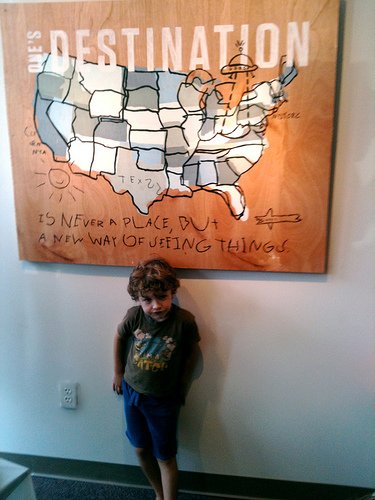Is graphic design art? The debate, for me, started in art school and now lives on in the offices of Journey Group, the creative agency where I work. Although there are convincing arguments for both sides, the argument for me revolves around the idea of constraints.
As design director at Journey Group, I have had the good fortune of designing a wide variety of projects for many clients — websites for international relief agencies, wine bottle labels for wineries, books for the U.S. Postal Service.
One reason I love design is that, unlike art, constraints abound. While artists may strive to escape the box, this designer enjoys its coziness. I never experience paralysis in front of a blank page when starting a design project the way I do for an art project. Constraints are my ally. And there’s a host of predetermined parapets.
In and of itself, working for a client is a large constraint. My work must communicate their message to a specific audience. Usually, the visual brand of the client limits the palette. And most of the time, the canvas is predetermined (website, book, magazine, etc).
But when I was asked to create a piece of art for a gallery show, paralysis came quickly and loitered a long time. The freedom to do anything was overwhelming. The antidote to blank-page paralysis was constraints. But, this time, the parameters had to be self-imposed.
To help me begin, I decided to make do with what I had around the house. This helped narrow the scope of my creativity. My palette became and old box of meager craft paints, a scrap piece of wood, my canvas. I even chose to involve my 5-year-old in the piece to help me loosen up.
But still, as in graphic design, it’s hard to start without something to say. It’s equally difficult to imagine that writers would have this same problem, but my wife – a poet – assures me this is true. I didn’t simply want to make a piece to take up space on the wall; I wanted it to communicate with the audience. I found my inspiration in a simple and profound quote from author Henry Miller: “One’s destination is never a place, but a new way of seeing things.”
With an idea to communicate and my canvas fenced with constraints, I was eager to begin. My son and I each drew a map of the United States of America — a host of unexplored destinations for both of us — as we saw it. My painting was rigid, his drawing was carefree. I layered our maps onto the wood canvas. I also incorporated our inspirational quote in my rigid typography and his youthful handwriting.
What do you want to say? Once you’ve found that message, or once that message finds you, employ boundaries. Limit your palette. Select an appropriate canvas or setting. Leverage constraints as much as you can to start yourself working. With a fenced yard, creativity is free to run wild.
Mike Ryan is a Design Director at Journey Group in Charlottesville, Virginia. Oh, and married to Streetlight poetry editor Lisa Ryan.
Follow us!Share this post with your friends.

